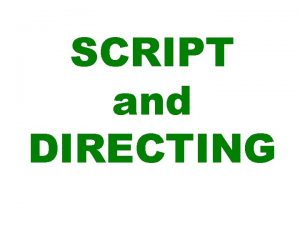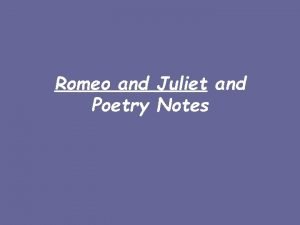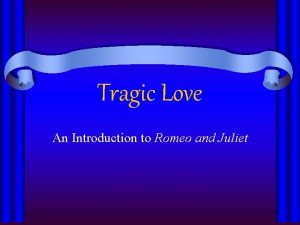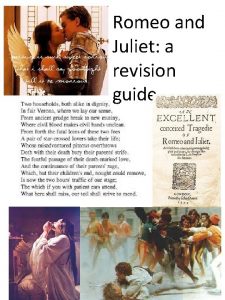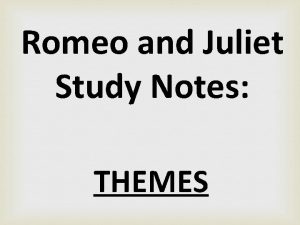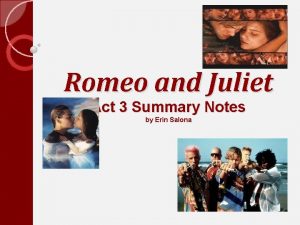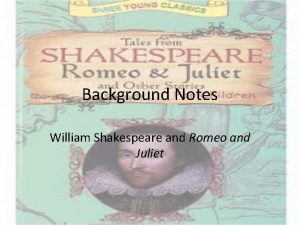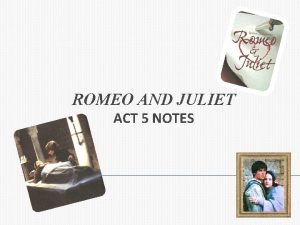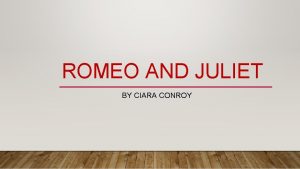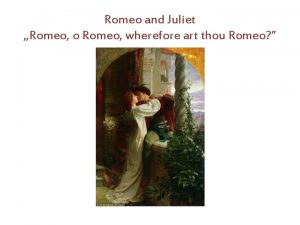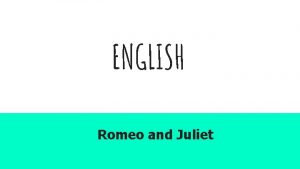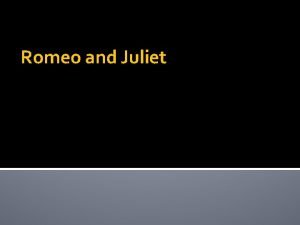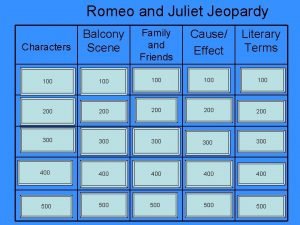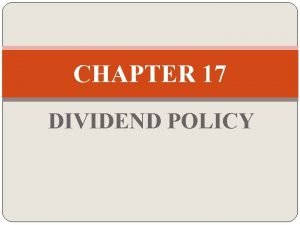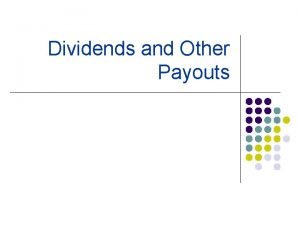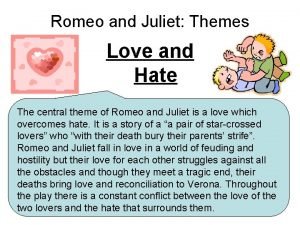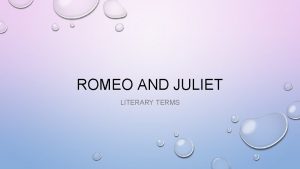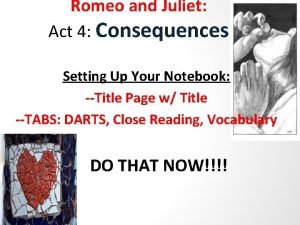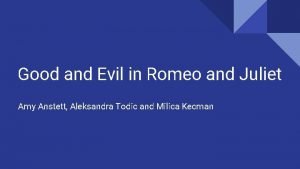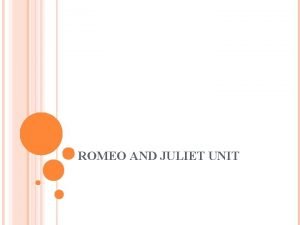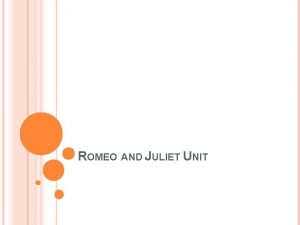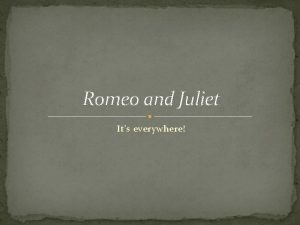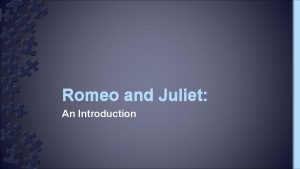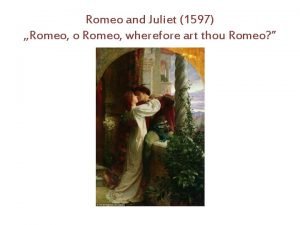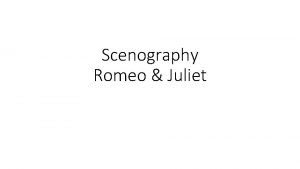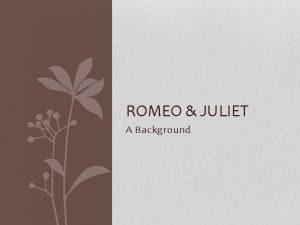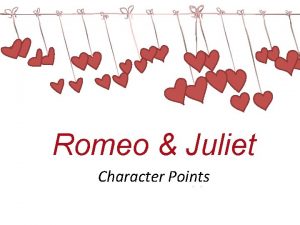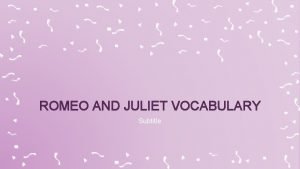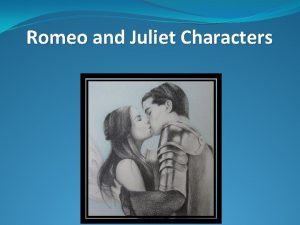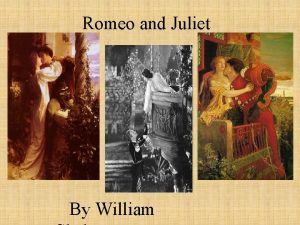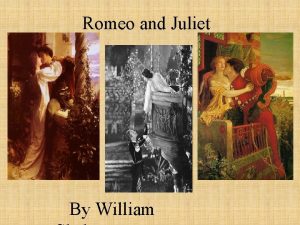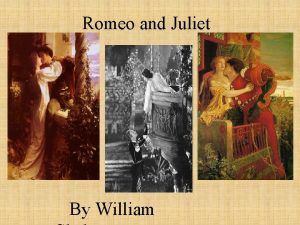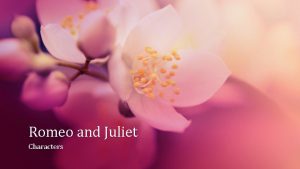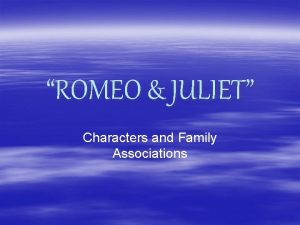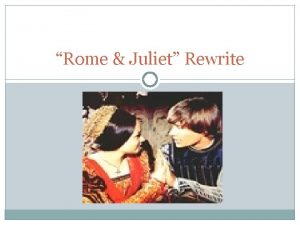Romeo and Juliet and Poetry Notes Date of























- Slides: 23

Romeo and Juliet and Poetry Notes

• Date of composition: between 1594 -1595 • Got idea from Arthur Brooke’s poem “The Tragicall Historye of Romeus and Juliet”

Romeo and Juliet is written in both prose and poetry

–Prose: spoken mostly by common people; occasionally by Mercutio when he is joking –Poetry: Most everyone else speaks in poetry

Prose • Ordinary speech without any structured beat • Written in paragraph form

Poetry • The poetry is written in unrhymed iambic pentameter

• Unrhymed iambic pentameter is called blank verse • (Blank verse means there is no rhyme at the end of the lines---Shakespeare used this about 93% of the time)

Iambic Pentameter • Iambic pentameter- line consisting of 5 iambs • Iamb- metered foot composed of an unstressed syllable followed by a stressed syllable • U = unstressed / = stressed

• Example: • u / u / u / • He jests at scars that never felt a wound. • 1 2 3 4 5

es of poetry are either end-stopped or run-on.

• End-Stopped Line: Has some punctuation at its end • Run-On Line: *no punctuation at its end

Examples O Romeo, Romeo! Wherefore art thou Romeo? Deny thy father and refuse thy name; Or, If thou wilt not, be but sworn my love, And I’ll no longer be a Capulet. End Stopped The brightness of her cheek would shame those stars As daylight doth a lamp; her eyes in heaven Would through the airy region stream so bright That birds would sing and think it were not night. Run-On

A sonnet is a fourteen-line poem.

A Shakespearean has three four-line units, or quatrains, followed by a concluding two-line unit, or couplet.

• Shakespeare uses couplets to show an end we should note –Somebody leaving a place says a couplet –The last two lines of an Act or Scene are a couplet

Famous Couplet Spoken by Juliet Good night, good night! Parting is such sweet sorrow That I shall say good night till it be morrow.

Rhyme Scheme is the pattern of end rhymes in a poem.

The rhyme scheme of a poem is indicated by the use of a different letter of the alphabet for each new rhyme.

• The most common rhyme scheme for the Shakespearean sonnet is abab cdcd efef gg.

• Label the following on the poem in your notes: –Rhyme Scheme –Quatrains –Couplet

Sonnet 29 • When, in disgrace with Fortune in men’s eyes, A • I all alone beweep my outcast state, B • And trouble deaf heaven with my bootless cries, A • And look upon myself and curse my fate, B

• Wishing me like to one more rich in hope, C • Featured like him, like him with friends possessed, D • Desiring this man’s art, and that man’s scope, C • With what I most enjoy contented least; D

• Yet in these thoughts myself almost despising, E • Haply I think on thee, and then my state, F • Like to the lark at break of day arising E • From sullen earth, sings hymns at heaven’s gate; F • For thy sweet love remembered such wealth brings G • That then I scorn to change my state with kings. G
 Romeo romeo where art thou romeo script
Romeo romeo where art thou romeo script Romeo and juliet poetry
Romeo and juliet poetry An introduction to romeo and juliet
An introduction to romeo and juliet Romeo and juliet revision notes
Romeo and juliet revision notes Major themes in romeo and juliet
Major themes in romeo and juliet Romeo and juliet summary
Romeo and juliet summary Romeo and juliet biography
Romeo and juliet biography Tragic love an introduction to romeo and juliet notes
Tragic love an introduction to romeo and juliet notes Romeo and juliet act 5 scene 3 summary
Romeo and juliet act 5 scene 3 summary Romeo and juliet act 3 vocabulary
Romeo and juliet act 3 vocabulary Ciara juliet
Ciara juliet Juliet capulet personality
Juliet capulet personality Romeo wherefore art thou
Romeo wherefore art thou Romeo and juliet key quotes and analysis
Romeo and juliet key quotes and analysis Unhappy fortune by my brotherhood
Unhappy fortune by my brotherhood Who said o romeo romeo wherefore art thou romeo
Who said o romeo romeo wherefore art thou romeo Romeo and juliet jeopardy
Romeo and juliet jeopardy Dividend payment
Dividend payment Ex date vs record date
Ex date vs record date West side story romeo and juliet comparison
West side story romeo and juliet comparison How is hate presented in romeo and juliet
How is hate presented in romeo and juliet Protagonist and antagonist in romeo and juliet
Protagonist and antagonist in romeo and juliet Romeo and juliet consequences
Romeo and juliet consequences Good vs evil in romeo and juliet
Good vs evil in romeo and juliet
